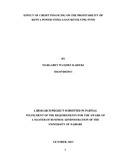| dc.description.abstract | Electricity infrastructure has been identified as one of the pillars that will facilitate the
Government of Kenya achieve its Vision 2030 objective of transforming Kenya into a
middle-income economy. In tandem with this objective, Kenya Power has set its 5
year Corporate Strategic Plan, to achieve a customer base of 3 million by 2016 from
the current total of about 1.9 million, (KPLC, 2012). However, increasing its
customer base has been a major challenge as majority of the customers especially the
rural customers cannot afford to connect to the power grid due to high connectivity
costs. From the literature reviewed, connection subsidies and credit financing schemes
such as Kenya Power Stima loan scheme that allow customers to make payments over
time have been seen to be a good way to make connection charges affordable. The
provision of credit financing however entails negative effects such as credit risk or
late payment, as well as high investment costs which may negatively affect a firm’s
profitability.
The research objective was therefore to establish the effect of credit financing on the
profitability of the Stima Loan revolving fund. This research project uses a classic
example of Mount Kenya South region which is a strategic business unit of the Kenya
Power and which had a total of 2877 Stima loan customers who formed the target
population for this research work. The quantitative data collected included data on the
Stima loan customer base, costs incurred in connecting the Stima loan customers and
subsequent profits generated from these additional customers. Cost Benefit Analysis
was used to assess the profitability of the Stima Loan Scheme. The statistical data was
analyzed using excel spreadsheet. Before analysis, data was prepared through
recording, coding, classification, tabling so as to derive some relevance. Findings
reveal that an increase in customer connectivity as a result of Stima loan scheme is
seen to impact on the Mt Kenya South regions revenues generated as a result of
increased unit sales. Findings also indicate that a high default rate hinders an
organization from achieving adequate profitability. The study concludes that there
should be proper monitoring of loan amounts disbursed and more frequent follow-ups
of the defaulters to reduce the overall credit risk to avoid exposing the company to
unnecessary high levels of risk. Further studies are encouraged to investigate the
extent to which Stima loan scheme has facilitated connectivity in Kenya, specifically
the rural areas. | en |

